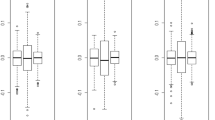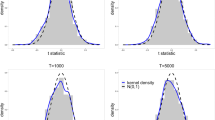Abstract
Given a fractional integrated, autoregressive, moving average,ARFIMA (p, d, q) process, the simultaneous estimation of the short and long memory parameters can be achieved by maximum likelihood estimators. In this paper, following a two-step algorithm, the coefficients are estimated combining the maximum likelihood estimators with the general orthogonal decomposition of stochastic processes. In particular, the principal component analysis of stochastic processes is exploited to estimate the short memory parameters, which are plugged into the maximum likelihood function to obtain the fractional differencingd.
Similar content being viewed by others
References
Baillie RT (1996) Long memory processes and fractional integration in Econometrics. Journal of econometrics 73: 5–59
Cheung YW, Diebold FX (1994) On maximum likelihood estimation of the differencing parameter of fractionally-integrated noise with unknown mean. Journal of Econometrics 62: 301–316
Bisaglia L (2002) Model selection for long-memory models. Quaderni i statistica 4, Liguori Editore: 33–49
Crato N, Ray KR (1996) Model selection and forecasting for long-range dependence processes. Journal of Forecasting 15: 107–125
Granger CWG, Joyeux R (1980) An introduction to long memory time series models and fractional differencing. Journal of Time Series Analysis 1: 15–29
Fox R, Taqqu MS (1986) Large-sample properties of parameter estimates for strongly dependent stationary gaussian time series. The Annals of Statistics 14: 517–532
Haslett J, Raftery AE (1989) Space-time modelling with long-memory dependence: assesing Ireland's wind power resource. Applied Statistics 38: 1–50
Hosking, J (1981) Fractional differencing. Biometrika 68(1): 165–176
Hurst HE (1951) Long-term storage capacity of reservoirs. Transaction of the American Society of Civil Engineering 116: 770–799
Karhunen K (1947) Über linear Methoden in der Wahrscheinlichkeitsrechnung. Ann. Acad. Sci. Fenn. (AI) 37: 1–79
Leland WE, Taqqu MS, Willinger, W, Wilson DV (1993) High time resolution measurement and analysis of LAN traffic: implication for LAN interconnection. Proceeding IEEE INFOCOM'91, Bal Harbor, FL, pp 1360–1366
Li WK, McLeod AI (1986) Fractional time series modelling. Biometrika 73: 217–221
Lobato, I., Robinson PM (1998) A non-parametric test for I(0). Review of Economic Studies 65: 475–495
Loève M. (1945) Fonctions aleatoires de second ordre. CR Acad. Sci. Paris, 200–469
Mathsoft (2000) Splus 2000
Mathworks (2000) Matlab, Version 6.1 Natick Massachuetts
Obled, Ch, Braud I (1988) Analogies entre geostatistique et analyse en composantese principales de processus ou analyse EOFs. In: Armstrong M (ed) Geostatistics, vol. 1, pp 177–188
Ramsey FL (1974) Characterization of the partial autocorrelation function. The Annals of Statistics 2: 1296–1303
Schmidt CM, Tschernig R (1994) The identification of fractional ARIMA models. Discussion paper of Humboldt University, Berlin
Sowell FB (1992) Maximum likelihood estimation of stationary univariate fractionally integrated time series models. Journal of Econometrics 53: 165–188
S-PLUS Guide to Statistical and Mathematical Analysis. Math Soft inc., Seattle Washington
Whittle P (1951) Hypothesis testing in time series analysis. Hafner, New York
Author information
Authors and Affiliations
Rights and permissions
About this article
Cite this article
Coli, M., Fontanella, L. & Granturco, M. Parametric estimation for ARFIMA models via spectral methods. Statistical Methods & Applications 14, 11–27 (2005). https://doi.org/10.1007/BF02511572
Issue Date:
DOI: https://doi.org/10.1007/BF02511572




